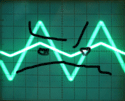|
Malcolm XML posted:How does the existing electronics in car ECUs deal with this probably by putting the signal through a special-purpose chip that was designed specifically for that one customer, has no datasheet publicly available, and only comes in super-annoying packages like DFN. also you can't buy them anywhere, but the manufacturer will send you a sample if you first sign 500 NDAs and prove to them that you have the capability to buy 500,000.
|
|
|
|

|
| # ? May 31, 2024 05:50 |
|
longview posted:1) just get a unidirectional TVS this is fantastic stuff, thanks i am glad you brought up the difference between absorbing noise and reflecting it. i had noticed that shorting the signal wire to ground makes the engine stall, and i was worried about the effect of a TVS effectively dropping a crowbar across those lines. so i reviwed my understanding of ignition coils and lol yeah i think my initial circuit would just kill the engine: - in between pulses, the coil is connected directly to the battery voltage (the noisy ~14v part of my trace) - a few degrees before the ignition event, the coil is disconnected from the battery, which allows a parallel capacitor to charge to ~400v instead (the low section) - at the moment of ignition, the line is reconnected and the capacitor discharges through the coil primary, producing 25kV on the secondary sooo i'm fairly sure that the giant spike is literally the coil drive pulse and if i knocked that out of the line well let's just say that would be not a successful strategy. lol so i'm liking your alternate strategy with the biased diode and small RC more and more. it's way more elegant and i can reuse it over and over for all of the other inputs (i am also gonna connect to five or six lines for the indicator lights, but fortunately those change slowly enough that noise filtering is trivial). AND it made me realize i can use something similar to clean up the signal from the thermostat, which is just a thermistor run into a voltage divider, but i was having trouble with it because one leg was on battery voltage which fluctuates like crazy. so yeah this is a huge help, thank you. i'm gonna start with your earlier circuit that just uses the bias and RC into an optoisolator and see if that works, cause i have most of the parts already, and if it still needs cleaning i'll look into the comparator method. i am looking for some diodes with high switching speed and high reverse voltage capacity for D1. the 1n4148 only handles like 100v so that won't do it. i found these ones that might work. do you think 75ns is fast enough based on the traces i posted, or should i go for these fancier silicon carbide guys that apparently have "no recovery time" for small currents? i really only need the one, since this is the only input channel with these specific issues, so i'm ok spending 2 bucks on the diode if it makes sense. 1kv schottky, 75ns, cheap 600v silicon carbide, "no recovery time" 1.2kv silicon carbide, "no recovery time" hobbesmaster posted:oh god, analog the circuit i'm trying to read is pretty fuckin analog so i don't think there's much of a choice here  someone posted about using an fpga to do the filtering but lol i have no clue how to start with that. i'm reading this stuff on an 8mhz ATTiny. at least i understand the concepts of analog filtering Luigi Thirty posted:I'm no EE but once I see "1000V" on a schematic I run screaming appears to be only about 400v in a spike but if it's really the capacitor discharge it would definitely pop a diode rated near the peak sooner rather than later Malcolm XML posted:How does the existing electronics in car ECUs deal with this modern car ecus don't do this at all. they have a hall or inductive sensor on the crankshaft and measure engine rotation directly, setting the spark timing and calculating RPM and such all in software. i'm retrofitting to a 30 year old motorcycle where the most advanced electronic device it came with is maybe the rectifier. i don't know exactly how the stock tachometer works, but with what i understand now about the input pulse, i suspect that it's electromagnetic. there might be a decently sized capacitor inside that gets charged up by the spark pulses, and that capacitor drives an electromagnet that attracts one end of the indicator needle. more frequent pulses lead to a higher voltage on the internal cap and a stronger pull on the needle -- sort of a crude analog PWM. it might be something else entirely (a more complicated analog circuit converting frequency to voltage) but i don't think there's anything digital. the gauge is definitely not driven with a stepper.
|
|
|
|
 this one looks cool too this one looks cool too
|
|
|
|
ah yea, that one would be doable in a car too, with a dry clutch. in a motorcycle the "flywheel" (alternator rotor or primary drive gear, depending on your interpretation) is internal and bathed in oil so you couldn't really do optical sensing.
|
|
|
|
what sort of complete rear end in a top hat routes pin 1 on a programming header to +5V and not GND
|
|
|
|
one that wants to sell hardware
|
|
|
|
in the schematic software pin 1 is on top so it looks neater to put a supply voltage there for my own boards i always ground the last pin on SIL headers and put a ground symbol in the silk next to the pin
|
|
|
|
i like to sprinkle lil grounded standalone 0.1" pins around my boards so there's always a convenient ground nearby for an oscilloscope probe with no risk of the dumb fat alligator clip shorting on anything
|
|
|
|
Bloody posted:i like to sprinkle lil grounded standalone 0.1" pins around my boards so there's always a convenient ground nearby for an oscilloscope probe with no risk of the dumb fat alligator clip shorting on anything This is pro advice. I've burned out a few DC/DC converters because of this.
|
|
|
|
I blew two fuses on my motorcycle in a row because of a scope probe ground clip shorting to the wire beside it
|
|
|
|
even proer if you can be bothered to get out the 0.1" pin ground lead clip that comes with most pro scope probes but then you can only get one probe per pin instead of a haphazard stack of alligator clips, just can't win also helpful to put a 2 pin header to bridge split ground/isolated inputs and to avoid making 1000  mistakes, always put series resistors on voltage test headers. especially if there are multiple supplies on adjacent pins mistakes, always put series resistors on voltage test headers. especially if there are multiple supplies on adjacent pins
|
|
|
|
my IIGS has no digital sound output. the ES5503 seems to be working but something's broken between it and the speaker. the legacy Apple II beeper works. time to break out the schematics and see what's going on here the sound circuit is on page 8, I can't see any of the discrete components on the board other than the op-amp ICs though? Luigi Thirty fucked around with this message at 20:12 on May 14, 2017 |
|
|
|
Have you checked the phone jack switch? The speaker out is switched through that so if it's corroded then it won't work.
|
|
|
|
Luigi Thirty posted:my IIGS has no digital sound output. the ES5503 seems to be working but something's broken between it and the speaker. the legacy Apple II beeper works. Do the IIGS's use surface mount electrolytics? Have those in your machine been replaced? They have a tendency to go bad and leak in 80's vintage apple machines.
|
|
|
|
longview posted:Have you checked the phone jack switch? The speaker out is switched through that so if it's corroded then it won't work. I get beeper noises through the speaker and my headphones, they're separate from the Ensoniq chip spankmeister posted:Do the IIGS's use surface mount electrolytics? Have those in your machine been replaced? They have a tendency to go bad and leak in 80's vintage apple machines. the sound section has the electrolytic caps yeah. they're not leaking or bulging though
|
|
|
|
ok not too familiar with old apples but looks like SPRK_H going into Q5 is the buzzer which rules out UK11 and UK10 as faulty. check the output of the differential-single ended converter (J25:3 might be a good test point), then you'll have to follow the signal path not too many electrolytics in the signal path other than the ones shared with the buzzer, signal path should be pretty simple to follow as long as you can find the op amps.
|
|
|
|
Luigi Thirty posted:I get beeper noises through the speaker and my headphones, they're separate from the Ensoniq chip It's specifically SMD lytics that are the issue, and you won't see them bulge.
|
|
|
|
longview posted:ok not too familiar with old apples but looks like SPRK_H going into Q5 is the buzzer which rules out UK11 and UK10 as faulty. the board is pretty crowded but the op amps are down next to the sound IC in the corner. I'll see if I can figure out where the signal's dying cloud
|
|
|
|
oh dammit half the sound poo poo is under the front of the case, thanks crapple i do get a signal on pin 3 of J25 when i have a sound file looping on the computer.
|
|
|
|
looks like they stuffed all the passives on the bottom layer, wonder if they wave soldered the bottom layer (if so there's usually traces of red glue around all SMD components on that side). based on recent experience my guess would be a cracked resistor will need to find UL11 or get to the bottom layer to check that though. you've already ruled out all of the DAC + UL12 which is good.
|
|
|
|
I was hoping it would be as easy as fixing the mouse port on my A2000 (the USB adapter got jostled which shorted something and blew an axial fuse on the +5V line) there aren't many photos of the back side of the motherboard online for some reason. i'll take it apart this week and see if I can spot anything burned out/broken/no continuity.
|
|
|
|
Luigi Thirty posted:the sound section has the electrolytic caps yeah. they're not leaking or bulging though doesn't mean they're not going bad recap the world
|
|
|
|
mostly out of idle curiosity, is there a public changelog from what changed between say ARM Cortex-A9 r3p0, r4p0 and r4p1?
|
|
|
|
nevermind, i think i found it
|
|
|
|
in tyool 2017 my employer is going into production on a brand new product, designs started from scratch in 2015 what did they pick to drive their analog knobs, leds, and buttons? an attiny88 featuring: - 512 bytes of ram - SPI controller with no FIFO and a shared data register between transmit and receive - no UART - obsolete toolchain - 8MHz clock speed - two PWM channels (and the board has 4 user-facing LEDs) - saves maybe 30 cents versus an equivalent m0, on a product that will cost several hundreds of dollars also none of the LEDs are on either of the PWM pins wish I had a hot tub time machine so I could go back and bunch that designer right in the dick Poopernickel fucked around with this message at 13:25 on May 23, 2017 |
|
|
|
Poopernickel posted:no FIFO and a shared data register between transmit and receive that's gotta be fun!
|
|
|
|
Poopernickel posted:in tyool 2017 my employer is going into production on a brand new product, designs started from scratch in 2015 hahahahahaha was this picked because someone prototyped with some kind of ~~maker~~ product? also lol at saving 30 cents for something that isn't gonna (I assume) break 10K units -- how many hours is $3K saved?
|
|
|
|
movax posted:hahahahahaha probably a safe bet on both
|
|
|
|
i can't even think of a "maker" product that uses an attiny88. there are a few boards that adafruit sells that use the tiny85 in order to be really small, but the 88 is physically the same size as the atmega328 on a bog-standard arduino so you'd think they would have just gone with that if they were prototyping that way? then you'd at least have 2k of ram and a UART
|
|
|
|
Poopernickel posted:in tyool 2017 my employer is going into production on a brand new product, designs started from scratch in 2015 greybeard hardware engineers are assholes
|
|
|
|
Poopernickel posted:in tyool 2017 my employer is going into production on a brand new product, designs started from scratch in 2015 but it doesn't actually need any more than that, why back in my day...
|
|
|
|
if they were true greybeards they'd be complaining that you weren't building your own oscillators for the PWM and doing the buttons with analog comparators
|
|
|
|
theyre prob the sorta ee that mumbles "you need a microcontroller? here, we always use this one" and slap down a piece of trash that went eol a decade ago but digikey still has thousands
|
|
|
|
see also: msp430 users
|
|
|
|
microcontrollers is chips with "not my problem" inside
|
|
|
|
Bloody posted:see also: msp430 users have you tried fram
|
|
|
|
Sapozhnik posted:microcontrollers is chips with "not my problem" inside
|
|
|
|
hobbesmaster posted:have you tried fram nope and i also always forget the use case for it even though i think its come up in this thread like 3 times at least
|
|
|
|
it's ram you don't lose when going to the lowest power mode and you don't burn through its rw cycles like flash
|
|
|
|

|
| # ? May 31, 2024 05:50 |
|
i don't think my workplace can even blink a LED let alone PWM it without a $200+ FPGA but then that's what happens when you have a ton of FPGA devs on staff hobbesmaster posted:have you tried fram we use cypress I2C fram in a work project since it's got fast and infinite writes. good for storing things like circular log buffers.
|
|
|



























